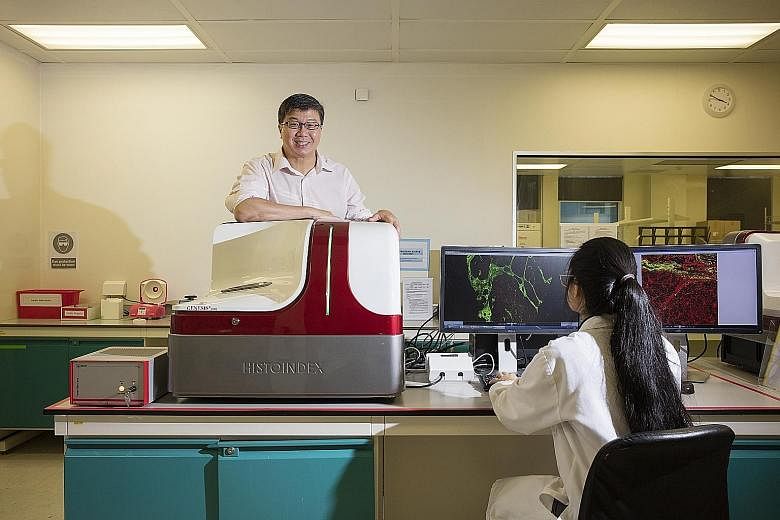Q Give us a quick overview of the company's background.
A HistoIndex was founded in 2010 as a spin-off company from the Agency for Science, Technology and Research's (A*Star) Institute of Biotechnology and Nanotechnology.
We developed a smart digital pathology system called Genesis, which automatically scans tissue samples and aids in the diagnosis of liver fibrosis.
Previously, this was done in a very manual way, with a lot of subjectivity involved. A biopsy is taken, where a tissue sample only one-cell thick is removed, stained with chemical dyes and examined under a microscope.
But different staining techniques and solutions can lead to very different results. Pathologists may also have different interpretations of what they're seeing.
Our machine uses artificial intelligence to scan biopsies on slides and can generate an analysis report. It is capable of capturing the most marginal improvements or changes in disease progression.
Our technology does not require staining - instead, an infrared laser beam passes through the sample and determines the tissue's level of health. The end result is a map of healthy and non-healthy tissue.
Q How are you making your mark internationally?
A We've grown a fair bit in terms of our expansion overseas, as well as what we can do.
We have 17 partners, all of which have at least one of our systems in their labs. Our technology is used in hospitals, research institutes, laboratories, as well as by pharmaceutical companies.
We are in Europe, the United States, China, Malaysia, Australia and are now thinking of moving into Thailand and India.
The latest and most exciting thing we're involved in is working with pharma companies on drug development. We don't develop drugs but we provide the tools used in drug development.
Our imaging system scans through tissue biopsies that have gone through drug development. Our technology can track minute changes and improvements in the tissue, so the pharma companies use the technology to assess whether their drugs are working well and if they can be improved.
We've been working with many pharma companies to develop drugs for non-alcoholic steatohepatitis (Nash), which causes inflammation and damage to liver cells.
It's a pretty big problem here - 50 per cent of the adult population suffers from a condition called fatty liver disease, which develops when the liver has difficulty breaking down fats.
Among these people, some will develop Nash. If left untreated, Nash can lead to liver cirrhosis, which develops when scar tissue replaces normal, healthy tissue. This can lead to liver cancer.
There are currently no US Food and Drug Administration-approved drugs available for Nash - pharma companies are in the process of developing them.
HistoIndex is working with about half a dozen pharma companies - mostly in the United States - in phases 2 and 3 of drug development.
Q The pharma industry is known for being difficult to break into. How did you manage it?
A With the pharma industry, it's almost like courtship. Unless you're very special, you won't get married within days. It starts with building relationships.
We started by working with pharma companies on their animal tests and tissue at the pre-clinical stage of drug development.
From there, we moved on to the clinical stages. We've worked with these pharma companies for the past 11/2 years.
To break in is not easy, but if you have demonstrated that your technology and tools work - that they are novel, effective and proven - then they'll be ready to take you on.
We publish papers, attend many conferences all over the world, present our data and show people that our technology works. There's no shortcut, just like courtship.
Q What does your involvement in the development of drugs for Nash mean for the company?
A Having a Singapore-developed technology from A*Star being used as a critical component to evaluate the efficacy of these drugs at such a late stage of development, with a few hundred million dollars worth of investment at stake - that's pretty exciting for us.
In future, we could become the new gold standard for Nash diagnosis.
When the first drug for Nash comes out in a few years, it will be a drug developed using our tools.
In order to take the drug, patients will go for a biopsy and this biopsy will be read using our machine.
The machine is like a thermometer - it will be used to diagnose the patient and based on that, the drug will be dispensed to patients. This means that we are likely to see even greater use of the machine.
Q How has the company grown?
A On average, we've been growing by 30 per cent every year since 2014. In the last financial year, our revenue, including other income, crossed the $2-million mark.
With what we're doing in the Nash space, we expect growth to jump to 100 per cent year on year.
We have a team of 27 people and we expect it to expand to 38 people next year. We intend to push big time into Nash so we're hiring many people in sales and marketing, as well as research and development.
The company has raised $2 million to arrive at certain strategic milestones and is looking to raise a further $5 million for rapid growth and expansion. Over the next one to two years, you should hear quite a lot from us.


